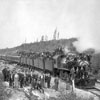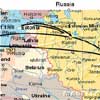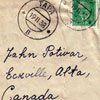1860-1900
 There are two conventional reasons that explain mass Estonian emigration to Canada at the end of the 19th century. The first has its roots in the poor social and political conditions that were present in the homeland, leaving many Estonians ostensibly dissatisfied. Maintaining a farm and raising a family were becoming increasingly strenuous objectives, and moving abroad could mitigate much of the hardship. Stories describing the large, vast lands of North America appealed to numerous Estonians eager to rid themselves of oppression. Canada's open immigration policy formed the second reason for mass departure. The land in Western Canada was extraordinarily cheap as the Canadian government wanted to populate the territory. For a mere $10, any settler over the age of 21 could obtain one quarter section (0.65 square km) as a homestead. If after three years the settler had cultivated at least 15 acres of land, he could obtain ownership with the possibility of purchasing more land.
There are two conventional reasons that explain mass Estonian emigration to Canada at the end of the 19th century. The first has its roots in the poor social and political conditions that were present in the homeland, leaving many Estonians ostensibly dissatisfied. Maintaining a farm and raising a family were becoming increasingly strenuous objectives, and moving abroad could mitigate much of the hardship. Stories describing the large, vast lands of North America appealed to numerous Estonians eager to rid themselves of oppression. Canada's open immigration policy formed the second reason for mass departure. The land in Western Canada was extraordinarily cheap as the Canadian government wanted to populate the territory. For a mere $10, any settler over the age of 21 could obtain one quarter section (0.65 square km) as a homestead. If after three years the settler had cultivated at least 15 acres of land, he could obtain ownership with the possibility of purchasing more land.
Migratory Routes: From Estonia to Alberta
 Estonians travelled various routes across Europe. Some ventured north and travelled by boat until they reached Britain while others used Europe's train system. One family boarded a small ship in Riga, Latvia and sailed across the Baltic and North Seas until they reached Hull, England. Upon arriving in Britain, families boarded large vessels which took them across the Atlantic. Conditions on board these ships were less than appealing. Often, families had no choice but to travel in unsanitary and overcrowded cattle liners. Moreover, ships transporting immigrants did not leave on a regular basis; instead, families would wait days, if not weeks, before boarding a ship traversing the Atlantic Ocean. It took over a week to navigate the rough ocean waters. Torrential storms and unrelenting waves exacerbated the already paltry conditions.
Estonians travelled various routes across Europe. Some ventured north and travelled by boat until they reached Britain while others used Europe's train system. One family boarded a small ship in Riga, Latvia and sailed across the Baltic and North Seas until they reached Hull, England. Upon arriving in Britain, families boarded large vessels which took them across the Atlantic. Conditions on board these ships were less than appealing. Often, families had no choice but to travel in unsanitary and overcrowded cattle liners. Moreover, ships transporting immigrants did not leave on a regular basis; instead, families would wait days, if not weeks, before boarding a ship traversing the Atlantic Ocean. It took over a week to navigate the rough ocean waters. Torrential storms and unrelenting waves exacerbated the already paltry conditions.
 Some families arrived in Halifax, Nova Scotia while others pushed further south, docking in New York City. Trains travelling from Eastern Canada and the United States to the open plains of the West were often overcrowded. Fortunately, boxcars were separated into two categories with units transporting people and others carrying their belongings, including livestock. A few families from Crimea headed west by train and eventually arrived in South Dakota. While some stayed, others found the land disagreeable and continued toward the Northwest Territories. (Prior to 1905 Alberta was considered part of the Northwest Territories). Initially, settlements were established by one family or by various families arriving from one particular area. For example, a community near Stettler-Big Valley grew with pioneers from Nurmekunde, an Estonian settlement in western Russia, while Barons was initially settled by families from Crimea arriving via South Dakota. Word of mouth or written letters exchanged between friends and families were the most popular methods of encouraging others to settle in particular areas. Families were interested in attaining freedom and cheap workable land, and were willing to travel almost anywhere to find their niche.
Some families arrived in Halifax, Nova Scotia while others pushed further south, docking in New York City. Trains travelling from Eastern Canada and the United States to the open plains of the West were often overcrowded. Fortunately, boxcars were separated into two categories with units transporting people and others carrying their belongings, including livestock. A few families from Crimea headed west by train and eventually arrived in South Dakota. While some stayed, others found the land disagreeable and continued toward the Northwest Territories. (Prior to 1905 Alberta was considered part of the Northwest Territories). Initially, settlements were established by one family or by various families arriving from one particular area. For example, a community near Stettler-Big Valley grew with pioneers from Nurmekunde, an Estonian settlement in western Russia, while Barons was initially settled by families from Crimea arriving via South Dakota. Word of mouth or written letters exchanged between friends and families were the most popular methods of encouraging others to settle in particular areas. Families were interested in attaining freedom and cheap workable land, and were willing to travel almost anywhere to find their niche.








